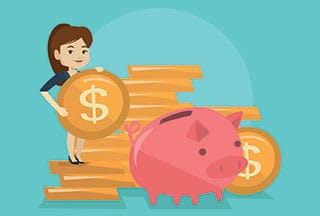
When going through a divorce, arriving at a financial settlement is incredibly stressful – even more so when you are the “non-moneyed” spouse. When you’re not accustomed to handling family finances, even monthly budgeting and check writing may be a new experience. When extending the process to include investments, taxes, and providing for your long-term financial security, moving forward financially can be overwhelming.
Each family situation and divorce financial settlement is unique, so there are few clear roadmaps to guide you. Matrimonial settlements include a division of marital property, and perhaps a period of maintenance (spousal support) and child support. The assets received from your settlement have varying degrees of liquidity from cash and securities to retirement accounts, real estate, and other assets. You probably need to address current one-off expenses as well as ongoing monthly living expenses. You will need to be responsible for income taxes, insurance matters, managing your investment portfolio and planning for your eventual retirement. Being solely responsible for your financial destiny is more than just stressful – it is exhausting.
Can Investments from Your Divorce Financial Settlement Sustain You?
Following the financial settlement, your immediate concern will be providing for the ongoing cash flow required to pay for your living expenses. Initially, you should set aside cash to cover about three months of expenses. This isn’t your “emergency” fund, rather, your living expenses while you set up your portfolio. When constructing a suitable asset allocation, you will need to establish a pool of liquidity, perhaps, a money market account for emergencies to balance the composition of your investment portfolio. The remainder of the assets should be invested for the longer term through risk assets of varying degrees.
You should consider working with a financial planner to assist with the construction of your asset allocation. I’ll share a very common misconception: There is a temptation to invest completely in bonds as they provide the greatest immediate current yield – short-term cash flow. A more prudent approach, after setting aside current living expenses and your emergency fund, is to begin methodically investing in a diversified portfolio of assets with an eye towards total return. A portfolio that combines a mix of equities and bonds, over time, will increase in value through a combination of interest payments, dividends, and capital appreciation, and also will keep up with inflation. See: “Need More Income: Seek Total Return.” It also is important that you understand the principle of “drawdown”: the amount of money you withdraw from your portfolio each year to meet expenses, and how it affects the portfolio’s value over time.
Understand Your Tax Situation
Another area where you likely will benefit from professional advice is coming to terms with your tax situation. You will need to understand your after-tax income and how different type of accounts can have different tax implications. At the time of this writing there has not been finality to a new tax law, but most likely, you will need to make quarterly estimated tax payments.
Other Financial Considerations
As if investments and taxes weren’t enough of a hassle, you will need to address revising your estate documents, particularly your Will along with other ancillary documents such as your Health Care Proxy and Power of Appointment. Next steps should include revisiting beneficiary designations on IRAs and life insurance policies. Although the list goes on, fortunately, there are many helpful checklists online.
Building your new financial life can be an arduous process, and most people similarly situated seek professional assistance, at least through the initial stages. Assuming control of your financial life can be frightening, but it’s also highly empowering.











Add A Comment